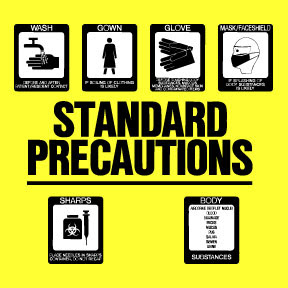Standard Precautions: Tier 1
- Perform hand hygiene before and after care and when soiled; most important way to prevent infection
- Use personal protective equipment (PPE) if touching, spilling, or splashing of blood or body fluids is likely; use gloves, gowns, mask, goggles, shields, aprons, head and foot protection
- Discard disposable items in fluid-impermeable bag and contaminated
- Do not recap used needles; dispose in sharps container
- Hold linen away from body; place in impermeable bag in a covered hamper; do not let hampers overflow
- Place lab specimens in a leak-proof transport bag without contaminating the outside; label with biohazard sticker and patient information
- Institute procedure for accidental exposure: Wash area, report to supervisor, receive emergency care, seek referral for follow-up
- Receive hepatitis B vaccine
- Assign patient to private room if hygiene practices are unacceptable
- Avoid eating, drinking, touching eyes, applying makeup in patient area.
Transition-Based Precautions: Tier 2
AIRBORNE
■ Used for microorganisms that spread through air (droplet nuclei 5 m) [e.g., TB, measles, chicken pox])
■ Private room; negative air pressure room; door closed; high-efficiency disposable mask (replace when moist) or particulate respirator (e.g., for TB); transport patient with mask, teach to dispose soiled tissues in fluid impervious bag at bedside
DROPLET
■ Used for microorganisms spread by large-particle droplets (droplet nuclei 5 m, (e.g., pneumonia [streptococcal, mycoplasmal, meningococcal], rubella, mumps, influenza, adenovirus)
■ Private room if available or cohort pts, mask when within 3ft of pt, door open, mask for pt when transporting, teach to dispose soiled tissues in fluid-impervious bag at bedside
CONTACT
■ Used for organisms spread by direct or indirect contact; methicillinresistant S. aureus (MRSA), vancomycin-resistant enterococcus (VRE), vancomycin intermediate-resistant S. aureus (VISA); enteric pathogens (e.g., E. coli, C. difficile), herpes simplex, pediculosis, hepatitis A and E, varicella zoster, respiratory syncytial virus
■ Private room or cohort pts; gowns, gloves over-gown cuffs; dedicate equipment



